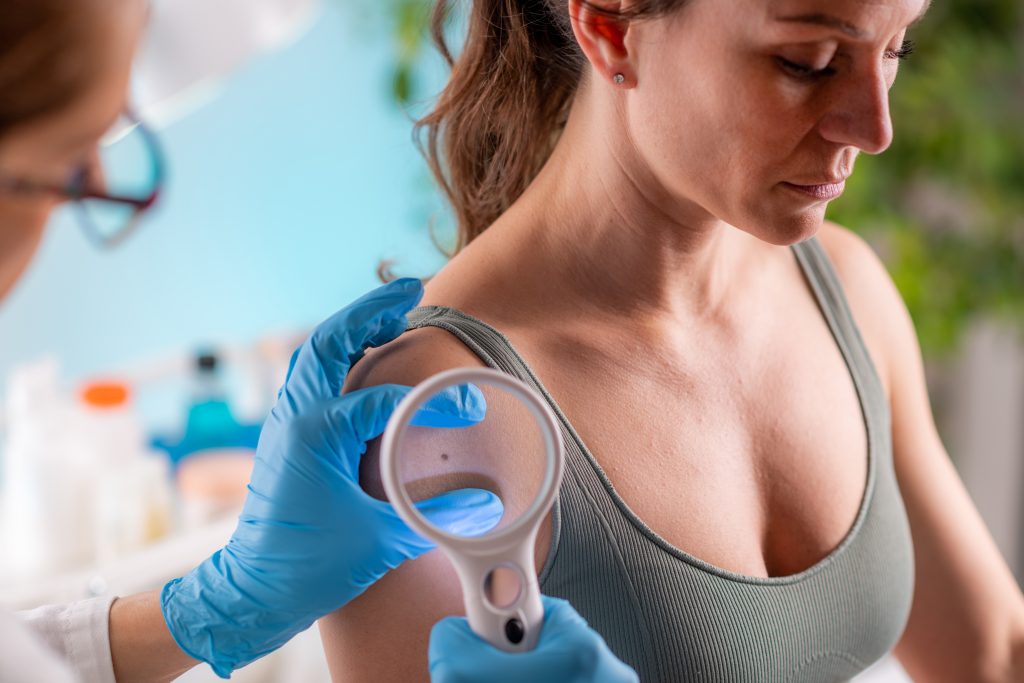Mohs Surgery
Mohs surgery is an outpatient procedure that is used to remove high-risk skin cancer and ensure that healthy tissue is preserved. This procedure involves the careful examination of tissue under a microscope and the gradual removal of layers to completely eliminate the tumor and achieve a high rate of successful treatment.

Why Mohs surgery is done
Mohs surgery can be utilized for the treatment of various types of skin cancers, such as basal cell carcinoma, squamous cell carcinoma, certain melanoma variants, and other uncommon forms of skin cancer. This procedure is employed specifically for addressing tumors.
- in regions where minimizing tissue removal is crucial, like the eyelids, ears, nose, lips, hairline, genitals, fingers, or toes
- these are bigger (in order to have a smaller mark)
- that have reoccurred or possess a high likelihood of reoccurring
- in areas where radiation therapy has been previously administered or where there is a visible scar
- that are growing quickly
- in people with immunosuppression
- with poorly defined edges (margins)
What should I anticipate prior to and during a Mohs surgery procedure?
In general, Mohs surgery takes place in a medical facility outside of a hospital, such as a dermatology office. Dermatologists can gain expertise in performing Mohs surgery through a fellowship program provided by the American College of Mohs Surgery (ACMS). To locate one of these trained specialists in your vicinity, you can visit the ACMS website.
The doctor’s office will give you specific instructions on how to prepare for your Mohs surgery. This may involve stopping certain medications, not smoking, and avoiding certain foods or drinks before the surgery. It is important to clarify any unclear instructions with your doctor’s office.
You should set aside the entire day for Mohs surgery as it can last for a few hours. The surgeon will numb the affected area using local anesthesia, allowing you to remain awake throughout the procedure.

Once the top layer of skin is removed, a bandage will be applied and you will be asked to wait in a designated area as a technician and the surgeon analyze the sample using a microscope. The surgeon will then inform you if another layer of skin needs to be taken or if the initial removal has successfully eliminated all the cancer cells. The ACMS states that typically, 1 to 3 stages are needed to fully eradicate the cancer cells in most tumors.
How It’s Done
Mohs surgery is performed either in a surgical facility or a doctor’s office that has a laboratory nearby. This allows the surgeon to conveniently analyze the removed tissue. Typically, the procedure takes approximately four hours, and patients are usually able to return home on the same day. However, it is important to allocate the entire day as the surgery might take longer than expected.
Prior to your surgery, the designated medical professional will sanitize the specific region. Subsequently, they will employ a specialized tool to mark the area and administer medication through a skin injection to ensure you do not experience any discomfort.
The surgeon plans to use a scalpel to eliminate the visible portion of the cancer. Additionally, they will extract a thin layer of tissue from beneath the visible tumor and apply a temporary covering. The tissue will subsequently be examined under a microscope in the laboratory. If any cancer remains, the surgeon will remove subsequent layers until no more cancer is detected.

Removing the skin may only require a few minutes, however, the examination process can be significantly lengthier, taking potentially up to an hour. To make the wait more bearable, you might consider bringing along a snack or a reading material.
Side effects
After undergoing surgery, it is possible to experience side effects; however, each individual may have a unique experience. These side effects can occur at any point during the surgery, directly afterwards, or in the days and weeks following Mohs surgery. Common side effects may involve:
- pain, tenderness or a burning sensation
- swelling
- bleeding and bruising
- infection
- scarring
- nerve damage such as numbness
Inform your healthcare team about any potential side effects from the surgery, as well as any other issues that you believe may be related. The earlier you communicate these problems, the sooner they can provide suggestions and assistance to help you manage them.
What is the recovery time for Mohs surgery?
It might take about two weeks for the recovery of Mohs surgery. Throughout this period, it is important to maintain cleanliness and dryness of the wound, apply ointment, and safeguard the area from direct sunlight.
After a week to ten days, it may be necessary to take out the stitches. Mohs surgery generally results in small scars for the majority of individuals.
Treatment in Türkiye:
The medical staff of surgical teams, doctors, and consultants at REHABTÜRK can provide the best treatment options and free consultations, striving to stay up-to-date on the latest medical technologies and methods.
